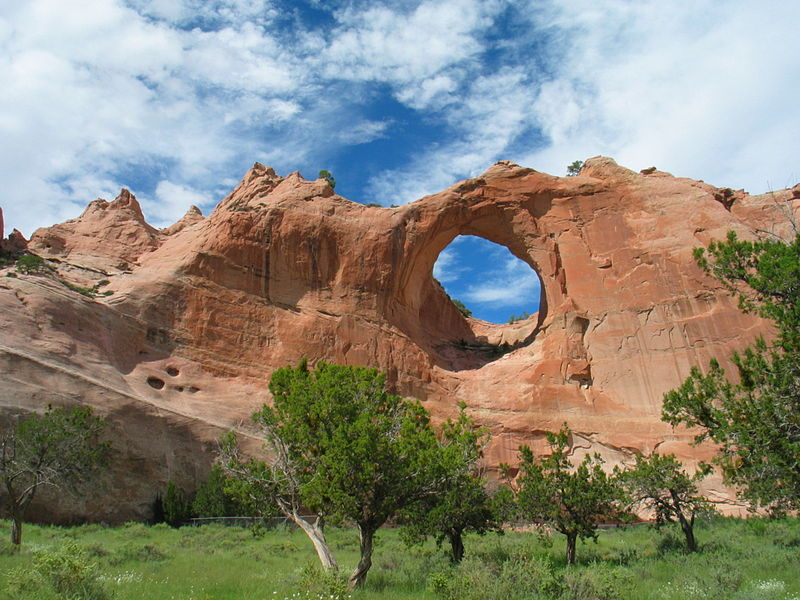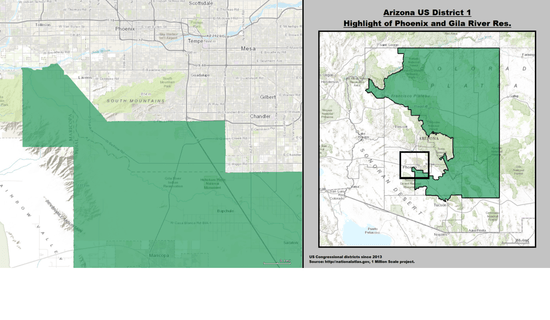 Window Rock
Window Rock
One thing you might not know about the U.S.’s Native American population is how widely distributed it is. Less than one-quarter of Native Americans (or, more specifically, members of the Census’s “American Indian and Alaska Native” category), for instance, live on tribal reservations, and the rest are distributed throughout both urban and rural parts of all 50 states, though more disproportionately in the West. If you count both people who are Native American alone, as well as Native American plus another race, the state with the largest number is, in fact, California (at 747,000)—though maybe that’s not that surprising since California has just about the most of everyone in every category. Only one state—Alaska—has an AIAN population of more than 10 percent, though, currently around 15 percent.
That same broad distribution applies to the nation’s congressional districts. There are only four CDs with a Native American population over 10 percent: one of them, of course, is Alaska, which has only one district for the entire state. The others are New Mexico’s 3rd district, Oklahoma’s 2nd district, and, at the top of the list, Arizona’s 1st congressional district, where 23 percent of the residents are Native American only.
Interestingly, you get a slightly different result if you include residents who are two or more races: Native American plus an additional race. In that case, Oklahoma’s 2nd narrowly edges out Arizona’s 1st, 26.7 percent to 25.3 percent. Oklahoma’s 2nd is only 17 percent, when you stick with residents who are Native American only.
But that represents a key historical difference between the Navajo and the Cherokee, who are America’s two most numerous tribes. The Navajo are the most numerous tribe if you count only members who consider themselves full-blooded (286,000 in 2010), but the Cherokee are the most numerous if you count all enrolled members. The large majority of Navajos live on the Navajo Nation, the nation’s largest (27,000 square miles) and most populous reservation, which is located primarily in Arizona’s 1st and New Mexico’s 3rd districts. However, very few Cherokees live on a reservation (only one of the three recognized Cherokee tribes has a reservation, which is located in North Carolina); most were forcibly relocated to the Indian Territory’s northeast portion (what is today Oklahoma’s 2nd district) but many dispersed from there after it became Oklahoma, many of them intermarrying members of other races.
Arizona’s 1st district’s Native American population is by no means limited to the Navajo, however. The sprawling Navajo Nation in Arizona’s northeast quarter covers much of the 1st’s territory, though the 1st is large enough that it covers most of the eastern half of the state. (The 1st still isn’t, however, the physically largest non-at-large CD; that distinction belongs to New Mexico’s 2nd district.) The 1st encompasses several other reservations, including the Gila River Reservation, which is located closer to Phoenix and is primarily home to the Pima tribe. Of the district’s 173,000 Native Americans, 112,000 are Navajo, 23,000 are Apache, 10,000 are Pima, and 9,000 are Hopi.
 Arizona’s 1st district
Arizona’s 1st district
Previous ancestors of Arizona’s 1st district in earlier decades, in fact, had a very unusual-looking gerrymander, with a squiggly cutout in the middle of the Navajo Nation attached by a long, thin thread to the next district over. This wasn’t intended to give either party any sort of political advantage, however; that missing piece was the Hopi Reservation, a smaller reservation surrounded entirely by the Navajo. It was a long-standing tradition to try to put the Navajo and Hopi Reservations in separate CDs so they would have separate representatives acting on their behalf in their long-running dispute over their reservation boundaries. (The Hopi are descendants of the Ancient Pueblo People—previously known as the Anasazi—while the Navajo are an Athabascan tribe who migrated to the area around the year 1400, so the Hopi still tend to think of the Navajo as the inconsiderate new neighbors.)
Despite its arid, wide-open spaces, most of the 1st’s population still lives in urban areas. The main population center entirely within the 1st is the college town and tourist destination of Flagstaff (population 70,000), but the 1st also takes in outer parts of the suburbs of both Phoenix and Tucson. It also encompasses a variety of smaller rural outposts throughout the state’s eastern half, including the heavily-Mormon outpost of Snowflake (its odd name comes from the names of its founders, Snow and Flake—the “Flake” half being an ancestor of current Arizona Sen. Jeff Flake) and Greenlee County, a copper-mining region that used to be Arizona’s lone Democratic stronghold thanks to unions.
The 1st has been represented since 2016 by Tom O’Halleran, who served as a moderate Republican in the state Senate in the 2000s but later became a Democrat. O’Halleran is a member of the Blue Dog Democrats, though that’s not surprising in one of the reddest House districts held by a Democrat: it gave Hillary Clinton 47 percent of the vote in 2016 to Donald Trump’s 48 percent, while Barack Obama lost the same territory to Mitt Romney 48 to 50. While the Native American population in the 1st is a strongly Democratic constituency, their turnout isn’t high while much of the rest of the district outside of the blue island of Flagstaff is rural and exurban Republicans.
The 1st has managed, however, to be represented by a Democrat since the last redistricting; before O’Halleran, it was held by Ann Kirkpatrick, who vacated the district to run unsuccessfully for Senate against John McCain in 2016. Kirkpatrick held the previous version of the 1st from 2008 to 2010, lost in the 2010 wave to Republican Paul Gosar, but then won the 1st back as an open seat post-redistricting when Gosar decided to run in the reconfigured 4th district instead. (Kirkpatrick is running to get back into the House this year, but she’s running in the adjacent Tucson-area 2nd district.)
O’Halleran benefited from drawing a very scandal-plagued Republican challenger in 2016, in the form of former Pinal County sheriff Paul Babeu. O’Halleran could face a difficult re-election in a future year, but doesn’t seem to be facing much difficulty in 2018, when Republicans are focusing their attention on being on the defensive elsewhere.
“The Most District” is an ongoing series devoted to highlighting congressional district superlatives around the nation. Click here for all posts in this series.
Leave a Reply